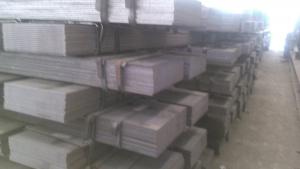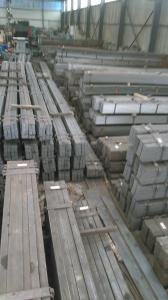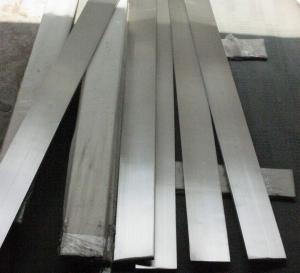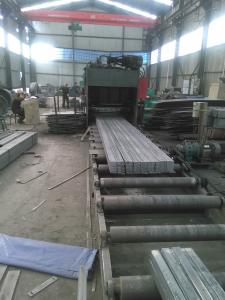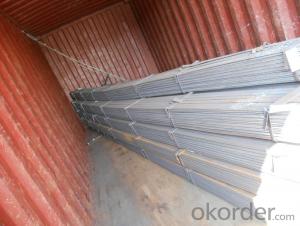Iron Flat Steel Bars Slitted by Cutting Machine
- Loading Port:
- Tianjin
- Payment Terms:
- TT or LC
- Min Order Qty:
- 50 m.t.
- Supply Capability:
- 10000T m.t./month
OKorder Service Pledge
OKorder Financial Service
You Might Also Like
Product Description:
OKorder is offering Iron Flat Steel Bars Slitted by Cutting Machine at great prices with worldwide shipping. Our supplier is a world-class manufacturer of steel, with our products utilized the world over. OKorder annually supplies products to African, South American and Asian markets. We provide quotations within 24 hours of receiving an inquiry and guarantee competitive prices.
Product Applications:
Iron Flat Steel Bars Slitted by Cutting Machine are ideal for structural applications and are widely used in the construction of buildings and bridges, and the manufacturing, petrochemical, and transportation industries.
Product Advantages:
OKorder's Iron Flat Steel Bars Slitted by Cutting Machine are durable, strong, and wide variety of sizes.
Main Product Features:
· Premium quality
· Prompt delivery & seaworthy packing (30 days after receiving deposit)
· Can be recycled and reused
· Mill test certification
· Professional Service
· Competitive pricing
Product Specifications:
Manufacture: slited
Slitting precision (width) : 0.5 mm or less
Raw material: Q235B, Q345B, Q235-1 b
crosscutting precision (length) : 2 mm or less
Processing: the thickness of 2.0-16 mm;
Shear length: 2000 mm above
Wide degree: 15-1250 - mm;
Leveling precision: 1-2 MM square
Packaging: Export packing, nude packing, bundled
FAQ:
Q1: How many tons of steel products could be loaded in containers?
A1: Usually the steel products are delivered by bulk vessel because of the large quantity and the freight. However, there are no bulk vessel enter some seaports so that we have to deliver the cargo by containers. The 6m steel product can be loaded in 20FT container, but the quantity is changed according to the size, usually from 18tons to 25tons.
Q2: what is the difference between actual weight and theoretical weight?
A2: All the section steel has two weights: actual weight and theoretical weight. Actual weight is the weighing out when the product delivered from the mill. Theoretical weight is calculated by pieces. The invoice can be based on each of them as your request.
Q3: How soon can we receive the product after purchase?
A3: Within three days of placing an order, we will arrange production. The normal sizes with the normal grade can be produced within one month. The specific shipping date is dependent upon international and government factors, the delivery to international main port about 45-60days..
Images:
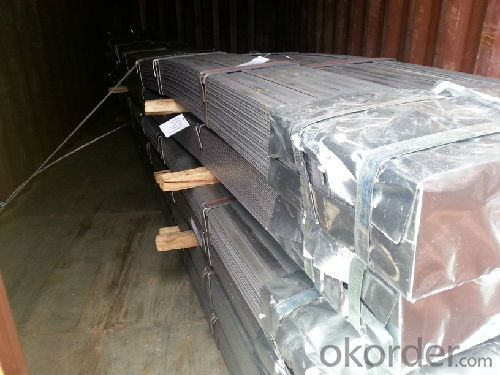
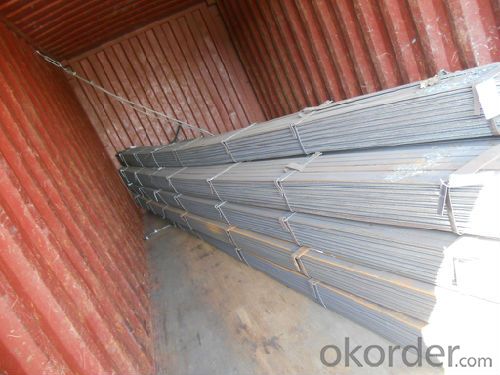
- Q:Can steel flat bars be anodized?
- Steel flat bars cannot be anodized; the process is primarily for aluminum and its alloys. Anodizing involves immersing the metal in an electrolyte solution and passing an electric current to create a protective oxide layer. This layer forms by bonding oxygen ions with the metal. Unlike aluminum, steel, composed mostly of iron, does not develop a similar oxide layer through anodizing.
- Q:How do steel flat bars compare to aluminum flat bars?
- Steel flat bars and aluminum flat bars possess distinct properties and characteristics, rendering them appropriate for diverse applications. Regarding strength, steel flat bars generally exhibit a greater degree of robustness compared to aluminum flat bars. Steel is a denser and harder material, endowing it with superior tensile strength and rendering it less susceptible to deformation or bending under pressure. Consequently, steel flat bars are the preferred choice for applications demanding high load-bearing capacity or structural support. Conversely, aluminum flat bars are considerably lighter than their steel counterparts. Aluminum boasts a lower density, thereby conferring upon it a lightweight quality. This feature renders aluminum flat bars more manageable and transportable, particularly in applications where weight is a significant concern, such as in the aerospace or automotive industry. Another crucial factor to consider is corrosion resistance. Aluminum naturally forms an oxide layer, which imparts exceptional resistance to corrosion, rendering it ideal for outdoor applications or environments characterized by high levels of moisture or humidity. Conversely, steel is prone to rust and corrosion unless adequately coated or protected. As a result, steel flat bars are better suited for indoor applications or areas with minimal exposure to moisture. Lastly, cost represents an additional consideration. Generally, steel flat bars tend to be more cost-effective than aluminum flat bars. Steel is a widely available and economical material, while the production and processing of aluminum can incur greater expenses. In conclusion, steel flat bars offer greater strength and durability, qualifying them for heavy-duty applications and structural support. In contrast, aluminum flat bars are lighter, exhibit greater resistance to corrosion, and are better suited for applications where weight plays a pivotal role. Ultimately, the choice between steel and aluminum flat bars hinges upon the specific requirements of the application, taking into account factors such as strength, weight, corrosion resistance, and cost.
- Q:Can steel flat bars be used for making storage systems?
- Indeed, storage systems can be fashioned using steel flat bars. Due to its durability and strength, steel proves to be an appropriate material for fabricating storage systems capable of enduring substantial weights and offering structural reinforcement. Steel flat bars present an opportunity to construct shelves, racks, and frames to accommodate storage systems found in warehouses, retail establishments, or even residential or office spaces. Moreover, steel flat bars can be effortlessly welded, cut, and molded according to precise design prerequisites, rendering them versatile in crafting tailor-made storage resolutions.
- Q:What is the weight of a standard steel flat bar?
- The weight of a standard steel flat bar may differ based on its dimensions and the specific type of steel utilized. Nonetheless, generally, the weight of a standard steel flat bar can be determined by multiplying the density of steel (typically around 7850 kg/m³) with the bar's cross-sectional area, which is ascertained by its width and thickness. The weight of a steel flat bar can be calculated using the formula: Weight (kg) = Width (mm) x Thickness (mm) x Length (m) x Density (kg/m³). By employing this formula, one can ascertain the weight of a particular steel flat bar based on its dimensions.
- Q:How do you prevent pitting or cracking on steel flat bars?
- There are several measures that can be taken to prevent pitting or cracking on steel flat bars: 1. Store the steel flat bars in a dry and well-ventilated area to avoid moisture exposure, which can lead to corrosion and pitting. 2. Apply a suitable protective coating, such as paint, varnish, or specialized anti-corrosion coatings, to create a barrier against moisture and other corrosive elements. 3. Clean the steel flat bars regularly to remove dirt, debris, or corrosive substances that may accumulate on the surface. Use mild detergents or safe cleaning solutions for steel. 4. Handle the steel flat bars with care to prevent impact or excessive loads that can cause cracking. Avoid dropping or mishandling the bars during storage, transportation, or installation. 5. Securely fasten the steel flat bars when moving or transporting them to prevent movement or rubbing against each other, which can result in pitting or scratching. 6. Protect the steel flat bars from extreme temperatures, especially rapid cooling or heating, as this can cause thermal stress and potential cracking. Allow the bars to acclimate gradually to temperature changes whenever possible. 7. Regularly inspect the steel flat bars to identify any signs of pitting, cracking, or corrosion. Promptly address any issues by cleaning, repairing, or applying protective coatings as necessary. By implementing these preventive measures, you can minimize the risk of pitting or cracking on steel flat bars, ensuring their longevity and preserving their structural integrity.
- Q:What are the different types of surface defects in brass steel flat bars?
- There are various types of surface defects that can be found on brass steel flat bars, which can occur during the manufacturing, processing, or handling of the material. Some common surface defects in brass steel flat bars include the following: 1. Scratches: Shallow marks or abrasions on the surface of the flat bar that can be caused by mishandling, contact with sharp objects, or improper storage. These scratches can affect the bar's appearance and potentially weaken its structural integrity. 2. Pitting: Small, localized cavities or depressions on the surface of the flat bar. Pitting can occur due to exposure to corrosive environments or chemical reactions. It can compromise the smoothness of the surface and may lead to further corrosion if not treated. 3. Rust or corrosion: When exposed to moisture, humidity, or aggressive chemicals, brass steel flat bars can develop rust or corrosion. Rust appears as a reddish-brown coating on the surface and can weaken the bar over time. Corrosion can also result in pitting or flaking of the surface. 4. Dents or dings: Small deformations or indentations on the surface of the flat bar. These defects can occur during handling or transportation, especially if the bars are not adequately protected. While dents may not significantly impact the structural integrity, they can affect the overall appearance. 5. Roll marks: Surface imperfections that occur during the rolling process used to shape the brass steel flat bars. These marks can appear as ridges, depressions, or patterns on the surface. Although they may not affect the functionality of the bar, they can impact its aesthetic appeal. 6. Scale: The layer of oxides that forms on the surface of brass steel flat bars during heating or high-temperature processes. Scale appears as a thin, flaky coating that can be easily removed mechanically. While scale does not affect the structural integrity, it can impact the surface finish. It is important to understand that the severity of surface defects can vary, and the acceptability of certain defects depends on the specific application or industry standards. Regular inspection, proper handling, and appropriate surface treatment methods can help mitigate and prevent these surface defects in brass steel flat bars.
- Q:What are the different types of surface defects in galvanized steel flat bars?
- The different types of surface defects in galvanized steel flat bars can include dents, scratches, corrosion, uneven coating, and zinc skimmings.
- Q:Can steel flat bars be cold formed or hot rolled?
- Steel flat bars can be both cold formed and hot rolled. Cold forming involves shaping the steel at room temperature, often using a press or rolling machine. Hot rolling, on the other hand, involves heating the steel above its recrystallization temperature and then passing it through a series of rollers to shape it. Both methods have their advantages and are used depending on the desired properties and applications of the steel flat bars.
- Q:Can steel flat bars be used for making window frames?
- Absolutely! Window frames can be made using steel flat bars. These bars are highly versatile and are frequently employed in construction because of their robustness and endurance. When utilized for crafting window frames, steel flat bars offer exceptional support and stability. They can be effortlessly tailored to accommodate various window dimensions and designs. Moreover, steel flat bars possess excellent resistance to corrosion, rendering them suitable for outdoor applications. All things considered, opting for steel flat bars to manufacture window frames is a pragmatic decision that guarantees enduring and dependable windows.
- Q:How do you prevent steel flat bars from warping during welding or fabrication?
- To prevent steel flat bars from warping during welding or fabrication, there are several techniques and precautions that can be taken: 1. Proper storage and handling: Ensure that the steel flat bars are stored in a dry and stable environment to prevent any moisture absorption or exposure to extreme temperature fluctuations. Avoid bending or dropping the bars, as this can cause stress and deformation. 2. Preheating: Preheating the steel flat bars before welding can help reduce the risk of warping. This is especially important when working with thicker bars or when welding multiple bars together. Preheating helps to reduce thermal gradients and minimizes the stress caused by rapid cooling during welding. 3. Tack welding: Instead of welding the entire length of the bar at once, tack welding involves making a series of small welds along the joint. This helps to distribute the heat evenly and prevents excessive heat buildup in one area, which can lead to warping. 4. Welding sequence: Plan the welding sequence carefully, starting from the center and moving outward. This helps to evenly distribute the heat and reduces the risk of warping. Avoid welding too quickly or applying excessive heat, as it can cause distortion. 5. Proper fixturing: Using proper fixtures and clamps can help hold the steel flat bars in place during welding, minimizing movement and potential warping. Ensure that the bars are securely and uniformly clamped to prevent any bending or distortion during the welding process. 6. Backstep welding: This technique involves welding in short sections and moving backward along the joint. By applying heat in a controlled manner and allowing each section to cool before moving on, the risk of warping can be reduced. 7. Post-welding stress relief: After welding, it is important to relieve any residual stress in the steel flat bars. This can be done through various methods such as heat treatment or mechanical methods like hammering or rolling. Stress relief helps to minimize the risk of warping and improves the overall stability of the bars. By applying these precautions and techniques, it is possible to minimize the risk of warping during the welding or fabrication of steel flat bars, ensuring a more precise and reliable end product.
1. Manufacturer Overview |
|
|---|---|
| Location | |
| Year Established | |
| Annual Output Value | |
| Main Markets | |
| Company Certifications | |
2. Manufacturer Certificates |
|
|---|---|
| a) Certification Name | |
| Range | |
| Reference | |
| Validity Period | |
3. Manufacturer Capability |
|
|---|---|
| a)Trade Capacity | |
| Nearest Port | |
| Export Percentage | |
| No.of Employees in Trade Department | |
| Language Spoken: | |
| b)Factory Information | |
| Factory Size: | |
| No. of Production Lines | |
| Contract Manufacturing | |
| Product Price Range | |
Send your message to us
Iron Flat Steel Bars Slitted by Cutting Machine
- Loading Port:
- Tianjin
- Payment Terms:
- TT or LC
- Min Order Qty:
- 50 m.t.
- Supply Capability:
- 10000T m.t./month
OKorder Service Pledge
OKorder Financial Service
Similar products
New products
Hot products
Related keywords





















